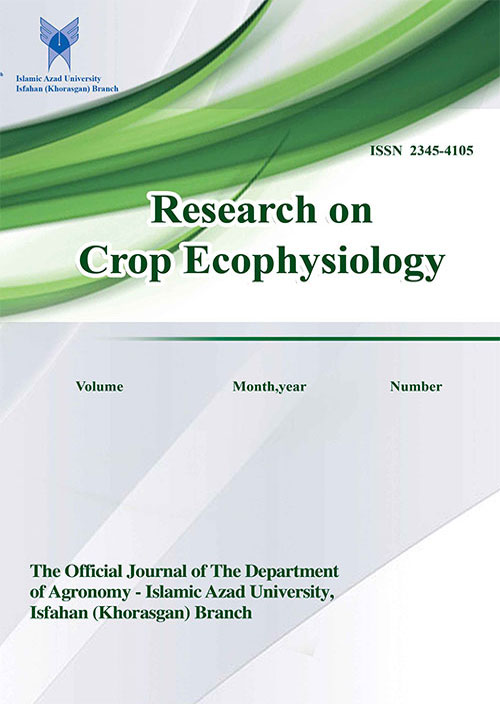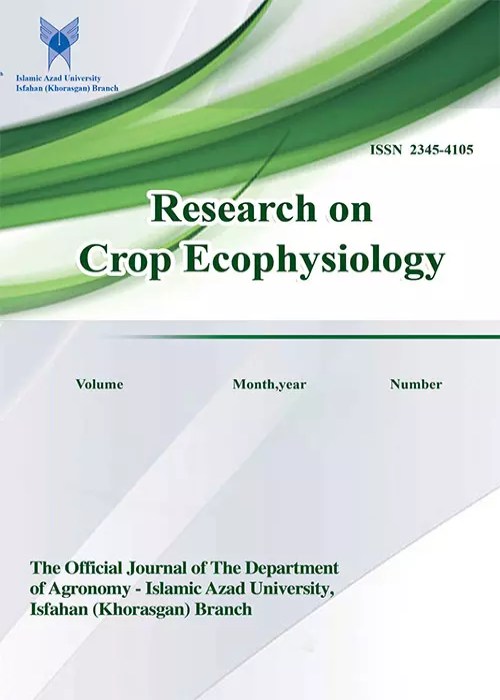فهرست مطالب

Journal of Research on Crop Ecophysiology
Volume:13 Issue: 2, Spring 2018
- تاریخ انتشار: 1399/12/02
- تعداد عناوین: 6
-
Pages 53-63
The wheatgrass (Agropyron cristatum L.), is a plant with potential source of turf in arid and semi-arid regions. It can be also cultivated in order to prevent the soil erosion by coverage of earth's surface. Drought stress is one of the most important factors that influence growth and productivity of plants in arid and semi-arid condition. In order to evaluate the effect of trinexapac ethyl concentrations (0, 0.25 and 0.5 kg/h) and drought stress (25, 50 and 75% of field capacity) treatments on some wheatgrass morphological traits, a pot experiment was conducted as factorial in completely randomized block designs with four replications in research greenhouses of Islamic Azad University, Isfahan (Khorasgan) Branch during 2015. The results showed that the maximum plant height and the lowest amount of proline obtained in 75% drought stress treatment. The lowest fresh weight of the aerial parts and the relative water content (RWC) were observed in 25% drought stress treatment. The highest dry weight of the shoots was measured in control, 0.25 kg/h trinexapac-ethyl and 75% drought stress treatments. The highest proline content and the lowest height of the plants were observed in 25% drought treatment with 0.5 kg/h oftrinexapac-ethyl. In general, the research results indicated that under drought stress condition, application of trinexapac-ethyl by increasing the amount of proline and relative water content reduced stress damage and increased resistance to drought stress in the wheatgrass.
Keywords: Agropyron cristatum L, Proline, Relative water content, Plant growth regulator -
Pages 67-71
In order to determine the best cold tolerant line of rice, Eight rice genotypes were compared in a randomized complete blocks design with three replicates in Saman town (one of the semi-cold places of Chaharmahal and Bakhtiari province) during 2012-2013. Results of combined analysis of variance showed significant differences among the genotypes for studied traits including; the number of days to the phenological stages (emerging 50% of panicles and 80% of maturity), plant height, the number of fertile and non-fertile tillers per plant, the number of fertile and non-fertile grains per panicle, weight of one thousand seeds and grain yield. Genotype code 14 (Stevela) with the highest number of fertile tillers per plant and the lowest number of no fertile grains per panicle produced the highest grain yield (6.640 t/ha) and was ranked higher than other genotypes. Three other genotypes (codes 1, 3 and 7) with an average yield of tons per hectare were in a class lower than code 14 but higher than control genotypes. Two control genotypes were Koohrang and local Champa, had an average yield of 4.625 t/ha.
Keywords: White, Seed, Yield, Line, Bean -
Pages 73-77
In this study, 10 promising lines of white bean (Phaseolus vulgaris L.) along with Dorsa and Paak control cultivars were evaluated in a randomized complete blocks design with three replications over two years. During the growing season, the status of the lines was determined in terms of growth type, number of days from planting to flowering and maturity, number of pods per plant, number of seeds per pod, 100-seeds weight, single plant yield and total yield. Results of combined analysis of variance over two yearsfollowed by LSD test showed that grain yields of lines 7, 3 and 6 were 49%, 42% and 41% higher than the control, respectively. Of these three lines, line 3 was superior because of its higher 100-seedsweight. Therefore, this line is suitable for Shahrekord and similar areas. Correlation coefficients of grain yield and its main components were positive and significant. Further experiments to introduce Line 3 as a new cultivar will take place in the coming years.
Keywords: White, Seed, Yield, Line, Bean -
Pages 78-82
Pesticide residues and their derivatives in agricultural products are a serious threat to consumer’s health. Due to the use of barberry in the raw state, determination of the residual common pesticide residue is essential, which has not been done so far. This study aimed to evaluate the pesticide residues in the Berberis vulgaris by QuEChERS (quick, easy, cheap, effective, rugged and safe) extraction, and Gas chromatographic-mass spectrometry (GCMS) in Iran. In general, barberry fruit samples from Berberis vulgaris gardens from 6 different regions have been studied, in which Diazinon, Phosalone and Oxydemeton-methyl pesticides have been used, the durability of the effects of Diazinon, Oxydemeton-methyl and Phosalone pesticides on barberry extract was investigated within 15 days daily with three replicates. In this study, Diazinon has the least duration, until the 12th day. Oxydemeton-methyl has a weak downtrend in Barberry, and the Phosalone pesticide has more stability in this product during this investigation.
Keywords: Pesticide persistence, Berberis vulgaris, QuEChERS, Extraction -
Pages 84-93
In order to investigate the effect of different levels of salinity on varieties of mung seed germination in pot conditions a research was performed in summer 2013 in the Research Laboratory of Agriculture and Natural Resources University of Ahvaz. These experiments were performed in factorial mode in the form of completely randomized designs with two treatments and four replications. The first treatment included hybrid VC6371A, hybrid VC6371B and local Parto varieties. The second treatment included different levels of salinity based on electrical conductivity (EC) of the medium including: zero (control), 16, 12, 8 and 4 ds/m. The analysis was performed in the pot. In these experiments the germination traits such as germination percentage (G%), rate of germination (ROG), mean daily germination (MDG), the mean time of germination (MTG) and daily germination speed (DGS). The results showed that the interactive effects of varieties and different levels of salinity have significant effect on most of the traits under study. Also the varieties and levels of salinity had significant effect on ROG and G% (p < 0.05). In this experiment the specific variables such as ROG and G% of Parto variety were higher than the hybrid varieties; thus germination of the local Parto variety had greater resistance than the mentioned varieties under high salinity. Thus this appropriate trait could have a significant impact on increasing the final yield of this variety.
Keywords: Parto variety, Salinity, Rate of germination, Germination percentage, Pot cultivation -
Pages 94-102
Common bean is an important crop in Chaharmahal and Bakhtiari province with high water requirement and in recent years, due to water scarcity, its cultivation has declined sharply. In this experiment, deficit irrigation with change irrigation method in bean cultivars were investigated. Factorial experiment was conducted in a randomized complete block design with three replications in 2016 and 2017 at Chahartakhte Research Station in Shahrekord region. Cultivar with three levels (Koosha chitti bean, Yaghut red bean and Dorsa white bean) and irrigation method with three levels (strip-drip irrigation, furrow irrigation, and conventional (flood) irrigation (strip surface irrigation)) were used in this experiment. Combined analysis results showed that plant height, grain yield, yield components, and water productivity were affected by bean cultivars and irrigation methods. The highest grain yield was obtained from Yaghut red bean cultivar, which had a significant difference with Koosha chitti bean cultivar. The highest water productivity was obtained from Yaghut red bean cultivar, which had a significant difference with other common bean cultivars. The highest water productivity was obtained from strip surface irrigation, which did not have a significant difference with strip drip irrigation, while water use in strip drip irrigation was far less than strip surface irrigation. Therefore, it is possible to use drip irrigation with less water consumption.
Keywords: Common bean, Yield, Reduce irrigation, water productivity


